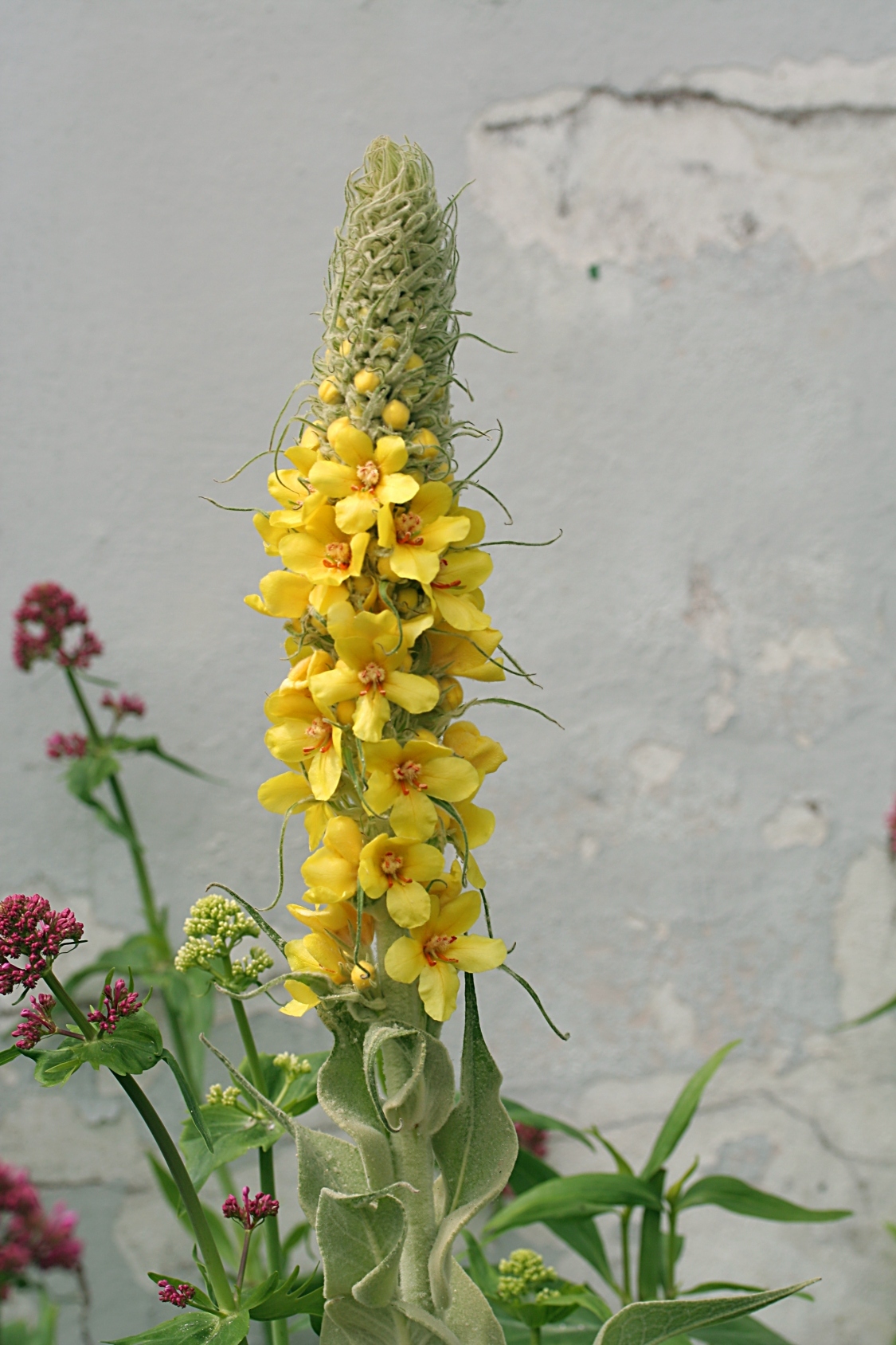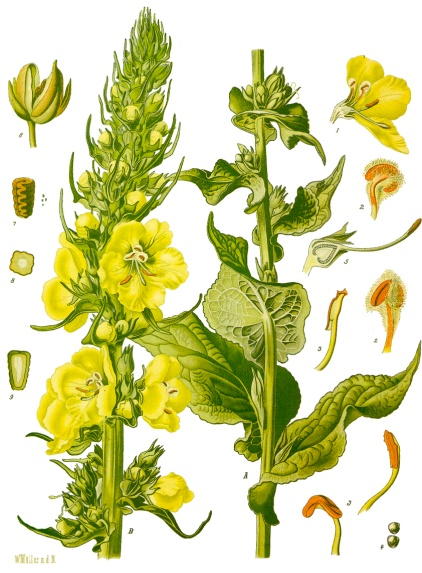
Verbascum thapsus (L)
 Synonyms: Aaron's rod, lady's foxglove,
cow's lungwort, clown's lungwort, bullock's lungwort, donkey's ears, torches, mullein dock,
velvet plant, velvet dock, Our Lady's flannel, Adam's
flannel, old man's flannel, woollen, rag paper, candlewick plant, wild ice leaf, Jupiter's staff, Jacob's staff, Peter's
staff, shepherd's staff, shepherd's clubs, beggar's stalk, beggar's blanket, golden rod,
clot, cuddy's lungs, duffle, feltwort, fluffweed, hare's beard, hag's taper, great mullein
Synonyms: Aaron's rod, lady's foxglove,
cow's lungwort, clown's lungwort, bullock's lungwort, donkey's ears, torches, mullein dock,
velvet plant, velvet dock, Our Lady's flannel, Adam's
flannel, old man's flannel, woollen, rag paper, candlewick plant, wild ice leaf, Jupiter's staff, Jacob's staff, Peter's
staff, shepherd's staff, shepherd's clubs, beggar's stalk, beggar's blanket, golden rod,
clot, cuddy's lungs, duffle, feltwort, fluffweed, hare's beard, hag's taper, great mullein
Order: Scrophulariaceae
Description: Verbascum is an erect biennial herb, common on waste ground in Europe and Britain, and naturalised in the USA. It consists of a rosette of very large, elongated, woolly, pale leaves, from the centre of which arises a thick, tough stem in the second year, producing a dense terminal spike of five-petaled yellow flowers. It can reach a height of 3.5m.
Parts used: leaves and stems; flowers
Collection: The leaves are collected in summer before they turn brown, the flowers between July and September.
Constituents: mucilage, gum, trace of volatile oil, resin, saponins (especially in the flowers), flavonoids (including hesperidin and verbascoside), bitter glycosides (including aucubin), tannins
Actions: relaxing expectorant, demulcent, mild laxative, mild diuretic, emollient, vulnerary, mild sedative
Indications: bronchitis, tracheitis, influenzal cold with respiratory catarrh. Topically in olive oil for inflamed mucosa. Specifically indicated in bronchitis with hard cough and soreness.
Therapeutics and Pharmacology: Verbascum
is a valuable remedy for most conditions affecting the respiratory system. It tones the mucous membranes,
reducing inflammation and stimulating fluid production, thus facilitating
expectoration. Its anti-inflammatory and demulcent action give it a useful role in tracheitis and associated conditions. It is a relaxing expectorant
for dry, chronic, hard coughs such as in whooping cough, tuberculosis, asthma
and bronchitis. The
leaves of Verbascum were once made into herbal 'tobacco' and smoked for asthma and
tuberculosis. The flowers are also effective for throat inflammations.
Steeped in olive oil, they make very
good eardrops, and the oil can be rubbed into rheumatic joints to ease the pain. A tea of
the flowers is reported to be sedative and may be used for insomnia. Verbascum is
also diuretic, helping to allay inflammation of the urinary system and countering
the irritating effects of acid urine. The leaves make an excellent poultice
for boils and sores
The flowers are also effective for throat inflammations.
Steeped in olive oil, they make very
good eardrops, and the oil can be rubbed into rheumatic joints to ease the pain. A tea of
the flowers is reported to be sedative and may be used for insomnia. Verbascum is
also diuretic, helping to allay inflammation of the urinary system and countering
the irritating effects of acid urine. The leaves make an excellent poultice
for boils and sores
Combinations: Combines well with Marrubium, Tussilago and Lobelia in acute or chronic bronchitis.
Caution: Infusions of the leaves should be strained through a cloth to remove the fine hairs which cover the plant as these may irritate the throat.
Preparation and Dosage: (thrice daily)
Regulatory Status GSL
Dried leaves: 4-8g or by infusion
Dried flowers: 1-2g or by infusion
Liquid Extract: 1:1 in 25% alcohol, 4-8ml
Additional Comments: Dioscorides recommended Mullein for scorpion stings, eye complaints, toothache tonsillitis and coughs. It was also traditionally taken for wasting diseases such as tuberculosis. An infused oil made from the flowers was a standby in many parts of Europe for ailments such as haemorrhoids and ear infections. Traditionally, the plant was regarded as antiseptic and the large leaves produced in the second season were wrapped around fruit to preserve it. The tall stems of mullein were once burned as tapers in funeral processions.
Bibliography
BHMA 1983 British Herbal Pharmacopoeia, BHMA, Bournemouth.
Grieve, M. 1931 A Modern Herbal, (ed. C.F. Leyel 1985), London.
Hoffmann, D. 1990 The New Holistic Herbal, Second Edition, Element, Shaftesbury.
Lust, J. 1990 The Herb Book, Bantam, London.
Mabey, R. (ed.) 1991 The Complete New Herbal, Penguin, London.
Mills, S.Y. 1993 The A-Z of Modern Herbalism, Diamond Books, London.
Ody, P. 1993 The Herb Society's Complete Medicinal Herbal, Dorling Kindersley, London.
Weiss, R.F. 1991 Herbal Medicine, Beaconsfield Arcanum, Beaconsfield.
Wren, R.C. 1988 Potter's New Cyclopaedia of Botanical Drugs and Preparations, C.W.Daniel, Saffron Walden.










